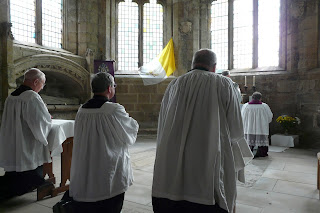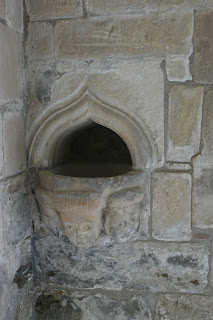Una Voce had arranged for Mass to be said in the Exraordinary Rite that morning. On the way through, we ran into some short but extremely heavy downpours, but just before 11am, we arrived at the Church in sunshine.
The building must be one of the finest Medieval Churches in Scotland, and much of the exterior of the building is intact, including the roof.
The Church began as a Parish Church in the 12th Century for the people of Seton Village.
By the 15th Century, it had become the private chapel and burial place for the Seton Family, who lived in the Castle next to the Church.
It was dedicated to St. Mary and the Holy Cross.
in 1470, Lord Seton introduced the College of priests, and his son gained Papal approval for full Collegiate status in 1492.
Collegiate Churches are so called because a number of priests would be brought there by a landowner to pray and offer Masses for him and his family.
But the Protestant Reformation brought an end to the Church. The altars, side chapels and statues were all destroyed by the fanatic reformers.The Masses ended.
Briefly it bcame a parish church, but fell into disuse.
After the 1715 Jacobite Rebellion, the Church was ransacked the Seton Family tombs were broken into, as the family had been supporters of the Catholic King James.
During the English incursions during the "Rough Wooing,", the English army burned the timbers and stole the organ and the Bell, in the 1540s.
At Saturday's Mass there was only a handful of people in the congregation. Unless you have a car, it is not that easy to get to.
It was a sung Mass, celebrated by Fr. Emerson.
http://en.wikipedia.org/wiki/Seton_Collegiate_Church
http://www2.thesetonfamily.com:8080/directory/Seton_Collegiate_Church.htm
http://www.historic-scotland.gov.uk/propertyresults/propertyoverview.htm?PropID=PL_243
http://www.unavocescotland.org.uk/uvsmassesevents.htm
http://www.unavocescotland.org.uk/























No comments:
Post a Comment